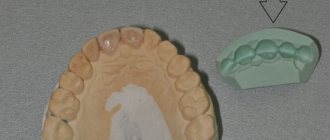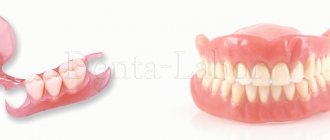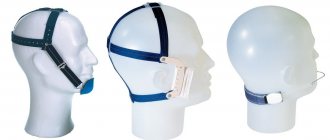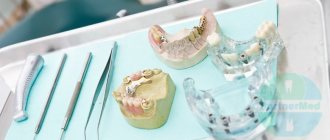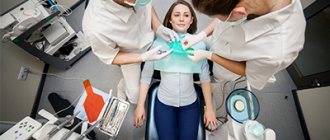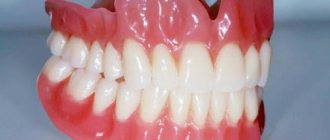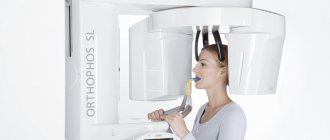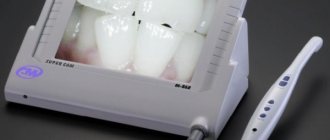- Indications
- Contraindications
- Advantages and disadvantages
- Kinds
- Clasp
- Made from nylon
- Lamellar
- Immediate dentures
- Manufacturing and installation
- Rehabilitation
- Care
- Prices
- Work examples
- Doctors
- Reviews
Despite the variety of implants, crowns and other methods of dental reconstruction, removable prosthetics does not lose demand, remaining an option for patients. Lightweight and strong structures compete with permanent dentures. This is a choice in cases where the patient cannot undergo implantation or have a fixed orthopedic system installed.
- When used:
missing from 1 tooth to completely edentulous - Type of anesthesia:
no need - Procedure time:
from 30 minutes (up to 4 visits) - Treatment period:
from 1.5 weeks to 3 weeks - Healing period:
from 3 weeks after the last removal - Age restrictions:
from 18 years old (in our clinic)
What dentures are best?
The type of system is selected individually. Taking into account the pros and cons of the designs, we draw the following conclusions:
- In case of partial loss of teeth and the presence of supporting teeth, clasp dentures will be an option. If there is an allergy to metals, choose QuattroTi dentures, acrylic, nylon models.
- If you have a toothless jaw, intolerance to acrylic and the impossibility of implantation, use plate Acry Free or nylon analogues.
Clasp dentures from 40,000 rub.
Nylon prostheses from 40,000 rub.
Lamellar dentures from 32,000 rub.
Butterfly prosthesis from 11,000 rub.
Quadrotti prosthesis from 64,500 rub.
Acri-Free prostheses from 47,000 rub.
Even with the same dental defects in two patients, prosthetics proceed differently. Only a doctor can tell which orthopedic product is the decision in this clinical situation, after examination and x-rays.
How to choose the best option
| Properties | Acrylic | Nylon | Akri-Free | Byugelny | Quadrotti | Sandwich | Butterfly |
| Aesthetics | average | high | high | relative | high | high | average |
| Strength | low | low | high | high | high | high | low |
| Allergy risk | There is | No | No | There is | No | There is | There is |
| Fixation | bad | bad | average | very good | good | good | bad |
| Comfort | short | short | high | average | high | average | average |
| Repair | available | not possible | available | available | available | available | available |
| Turning supports | not always | need not | need not | not always | need not | need not | need not |
| Service life (years) | 3-4 | 1,5-3 | 7-10 | 5-7 | 5-7 | 5-7 | 1-18 months |
| Price | low | low | average | high | high | high | low |
Advantages and disadvantages
Advantages
- Restoring the aesthetics and functioning of the dentition;
- used in complex clinical situations when reconstruction methods are impossible;
- selection of types of orthopedic products;
- installation without preliminary grinding of abutment teeth;
- variability of materials for manufacturing;
- without restrictions;
- speed of production and installation;
- repair of the orthopedic system in case of mechanical damage;
- ease of wearing and care;
- exceptional hygiene and safety;
- no age restrictions;
- use as a temporary prosthetic structure;
- service life (5-8 years);
- preservation of aesthetic indicators;
- price.
Flaws
- Restoration of chewing function is not complete;
- changes in diction, taste sensitivity during the period of adaptation;
- the likelihood of gum inflammation, irritation of the oral mucosa;
- uneven distribution of chewing loads;
- unable to stop or prevent jawbone atrophy;
- not all types of dentures and fixtures can be repaired;
- risk of damage to tooth enamel, development of cervical caries in the area where the attachments adhere to the supporting ones;
- relatively long period of adaptation;
- deformation and subsidence of the product (for metal-free structures);
- insufficient fastening on the lower jaw (applies to complete removable dentures).
Ultraneers
These are dental onlays up to 0.5 mm
. They are used to restore the front row of teeth and are installed on both the lower and upper teeth. They are analogues of veneers and lumineers.
To fix ultraneers, teeth are not ground, which is an undeniable advantage. Ultraneers solve the following problems:
- darkening and pigmentation of enamel;
- small cracks;
- unequal shape and size of teeth;
- large dental gaps.
The service life of ultranir is up to 15 years
. Care - normal daily oral hygiene, professional hygienic cleaning in dentistry regularly.
Types of removable denture systems
Removable dentures – orthopedic products. They are removed and installed in the oral cavity independently. Dentures are made from biocompatible, elastic materials. Two kinds:
- Partial removable - installed if the patient is missing one or more in a row. These are plate, clasp, and immediate dentures. They are attached to supporting teeth or implants with fixing elements. Evenly distribute the load when chewing between the supports and gums.
- Full removable – in case of loss of teeth on one or both jaws. In such situations, it is impossible to secure the denture to a rigid support. Alternative fixation is used. The chewing load is placed on the gums.
Modern technologies provide strong fixation and precise fit to removable orthopedic systems. Patients note the ease of use and care.
Lumineers
Another denture – overlays for restoring the aesthetics and functionality of a smile – are Lumineers. They are the thinnest plates up to 0.3 mm
and are fixed to the front row of teeth.
Unlike veneers, lumineers eliminate very minor defects. For example, enamel pigmentation, cracks, tooth color. Their main advantage is the absence of the need to grind teeth. They are attached using a special medical composition to healthy teeth.
A special feature of lumineers is their appearance - white and matte. The smile becomes dazzlingly white or, as it is also called, “Hollywood,” which does not always look natural.
Clasp dentures
Clasp dentures are orthopedic structures made of artificial teeth on a base replicating natural gums, fixed on a durable metal arch (clasp). They correctly distribute the load when chewing without overloading the dental system. The condition for installing a clasp structure is a sufficient number of supports (teeth or implants) to which it is attached with hooks or clasps.
Tabs
An inlay is an insertion into the cavity of a chewing tooth in order to restore its chewing function. It is made individually and fixed with medical cement. In fact, it replaces a filling and surpasses it in reliability and durability.
Tooth restoration with onlays (or inlays) is used in the following cases:
- tooth destruction by 20-50%
; - the presence of defects that are not comparable to the installation of the filling;
- exposure of enamel to increased abrasion;
- need to replace the old filling.
The inlays also differ in the type of material made and are:
- Metal
. Made from precious and medical metals. They are not aesthetically pleasing and can cause allergies. However, they are affordable. - Ceramic
. This is the most reliable material that perfectly restores the damaged surface. In addition, such an onlay will be absolutely indistinguishable from the original tooth. The ceramic onlay on the tooth is not stained and completely restores functionality and aesthetics.
Removable dentures made of nylon
A base made of thin, elastic nylon on which artificial dental crowns are attached. Products are manufactured based on the clinical situation.
- The bioinert material does not contain metal impurities and does not cause allergies
, so the structures are not removed at night. - Since the color of the base is matched to the natural shade of the gums, the design is not noticeable and looks natural
.
Among the advantages are price, speed of adaptation, convenience. The only drawback of the design is that soft nylon sags and becomes deformed. But even so, the service life is 5-8 years
.
Where in Voronezh can a partial removable denture be installed?
For a quality result, it is important to choose a dental clinic and attending physician wisely. Making the wrong choice can create a lot of problems and cost you a lot of time and money to fix the mistake. Be sure to pay attention to the specialist’s experience, the availability of modern equipment and reviews of other patients.
You can install partial removable dentures in Voronezh at. We offer production using modern equipment, high-quality materials and competitive prices. Our consummate specialists are always ready to help. We are waiting for you for your first free consultation!
Plate dentures
A group of prosthetic systems for partial or complete restoration. The basis of the structures is a soft base that imitates part of the oral mucosa, with artificial tooth crowns attached to it. Representatives of this group of orthopedic products are structures made from acrylic-free plastic alloy “Acry Free” and the elastic QuattroTi prosthesis.
- Partially removable QuattroTi
is an orthopedic system manufactured using 3D modeling technology. The approach ensures the fit of the structure and comfort of wearing. Elastic hook retainers do not require grinding of the supporting teeth, are invisible, and harmless to tooth enamel. - Lightweight, flexible Acry Free
made from non-allergenic composites combine appearance and comfort with service life (5 years) and price. Used for partial or complete restoration. The advantage of an orthopedic system is the ability to repair if damaged.
Made from bioinert materials, the flexible, soft base is not paintable and does not change color during service. They have a number of disadvantages, like similar orthopedic products.
Prosthetics of front teeth with veneers –
Dental veneers are microprostheses made of ceramic or composite filling material, which are used to cover the front surface of the teeth. Veneers can also eliminate problems with the color and shape of the front teeth, eliminate wide gaps between the front teeth, and thus they are a much more aesthetic, but also expensive alternative to light-polymer fillings (of course, if they are made of ceramic).
Ceramic veneers are the most aesthetic and high-quality. The best ceramic option in terms of aesthetics and reliability in this case would be the “E.max PRESS” material, but in a number of clinics veneers are also made from feldspathic ceramics (porcelain), or Noritake synthetic ceramics (Japan), or from zirconium dioxide with porcelain lining. Zirconium veneers are more expensive, but in terms of aesthetics they will be inferior to veneers from E.max PRESS.
Prosthetics of front teeth with veneers –
Insert teeth: prices for veneers made of ceramics and composites
- 1 porcelain veneer – about 15,000 rubles,
- 1 veneer E.max – from 21,000 to 28,000 rubles,
- 1 zirconium veneer – from 31,000 to 40,000 rubles.
There are also so-called composite veneers, which will be made from ordinary light-curing filling material - most often directly in the patient’s mouth (like a regular filling). The price for 1 unit will be from 6,000 to 9,000 rubles. And if ceramic veneers do not change their appearance over time, and their service life is limited only by the risk of mechanical injury, then composite veneers quickly change their appearance and will require replacement.
Immediate dentures
Removable immediate dentures - to replace defects in the dentition during the production of a permanent orthopedic system. There are three types of such models - full, partial, butterfly.
They cope with the task, return partial work to a lost dental unit and hide a visual defect. The disadvantages include fragility, fragility, and long addiction.
What are clasps
Clasps are hooks that are attached to the base of dentures in cases where the patient is partially edentulous and has several supporting teeth for fixation. As a rule, these elements are made of metal. For better aesthetics, less noticeable clasps in the color of enamel are used.
The use of such dentures is advisable for partially edentulous patients. That is, the patient must have his own teeth in his mouth. They serve as supports for structures of various types.
Manufacturing and installation of a prosthesis
Includes stages:
- Preparatory and diagnostic – after hygienic cleaning, treatment, the patient undergoes a survey x-ray, CT scan of the jaw, which requires prosthetics.
- The dentist takes an impression and sends it to a dental laboratory.
- The production of an orthopedic system lasts on average 2 weeks. New technologies for taking impressions and 3D modeling make it possible to create anatomically verified structures that reproduce the chewing surface of each element down to the smallest detail.
- The doctor tries on the finished denture for the patient and corrects any discrepancies.
The final stage is fixation of the product in the oral cavity.
Fixation of prostheses
Bugel, partial and full plate systems are attached to the mouth in different ways. Clasp ones are held in place with the help of clasps and attachments, partial plate ones - with soft fasteners, full plate ones - with a vacuum effect.
- Clasps
are metal hooks with which the prosthetic system clings to the base of the support units. - Attachments
are locks made of two components. One component is located on the prosthetic structure. The second is on the supporting tooth or implant. When putting on the orthopedic system, the clasp snaps tightly into place, holding the product in the mouth. - Vacuum effect
- flexible material fits closely to the gums and sticks to them. If necessary, increase the tightness of the seal, use “adhesive” pastes and gels.
Removable dentures are created using impressions from the patient. They are fixed in the mouth and do not fall out when chewing or playing sports.
Alekperov Roman Borisovich Dentist-orthopedist, doctor of the highest category
Is it necessary to remove a single tooth when performing removable dentures?
When talking about removable dental prosthetics of the lower jaw, they try to preserve their own teeth as much as possible. When replacing dentures in the upper jaw, single teeth must be removed. The decision is made by the doctor based on the clinical situation, after examination and diagnostic measures.
Alekperov Roman Borisovich Dentist-orthopedist, doctor of the highest category
There is only one tooth left on the upper jaw. Which denture should I choose so that the structure is held as tightly as possible and does not fall off?
If there is a single tooth in the upper jaw, only a partial, removable plate prosthetic system is likely to be manufactured. But such a design will not hold very firmly and in terms of reliability of fixation it is significantly inferior to prosthetics on implants. As an alternative, we recommend All-on-4, in which the denture is securely fixed to the jaw using only 4 titanium supports.
Alekperov Roman Borisovich Dentist-orthopedist, doctor of the highest category
On the left side of the upper jaw, 4 teeth in a row were lost. There are gold crowns on the lower jaw. Which removable denture is best placed on the upper jaw so that it does not conflict with the crowns?
In this case, it is possible to manufacture a partial removable lamellar denture based on acrylic or an Akri Free prosthesis. It is also possible to install the prosthesis on attachments or telescopic crowns. Since metal crowns are already present in the oral cavity, the best option would be Akri Free prosthetics.
Main advantages of the material
Nylon is lightweight and non-toxic material. Dentures made of nylon do not create the sensation of a foreign object in the mouth, and under the influence of the owner’s body temperature they can soften and become flexible. For the same reason, nylon dentures are resistant to stress during chewing.
The shape, color and design of the soft nylon denture base are matched to the shade of the patient's gums, so it is almost invisible.
To install a nylon removable structure, it is not necessary to grind adjacent teeth. It is attached to the teeth using dentoalveolar clasps (clasps or hooks) made of the same nylon, which are a natural continuation of the prosthesis and are invisible when smiling and talking. This makes it possible to carry out prosthetics in the most difficult areas of the jaw from an aesthetic point of view.
But it is worth considering that nylon dentures do not perform the chewing function very well, since when they soften under the influence of temperature, they lose the hardness necessary for processing food.
How to quickly get used to a removable prosthetic system?
After installing a denture, it will take time to get used to it. To ensure that adaptation proceeds without problems, we recommend:
- Do not remove from mouth for long;
- suck on lollipops to suppress the feeling of nausea;
- read aloud to practice clear diction;
- For the first few days, follow a gentle diet.
Addiction lasts on average 2-4 weeks. If discomfort persists for more than a month, pain intensifies, gums become inflamed and bleed, you should consult a doctor.
Are partial dentures repairable?
During use, individual parts of the prosthesis may break off. Under no circumstances should you attempt to repair it yourself; it is better to contact a specialist. If the situation can be corrected, it will only take a couple of days to fix it.
Every six months to a year, during a scheduled visit to the dentist, it is necessary to reline the plate and clasp structures, since the contour of the gums and the level of bone tissue change over time. The adjustment improves fit and load distribution, resulting in the product not chafing or breaking.
Caring for dentures
They are not difficult to care for. All that is needed:
- Clean morning and evening with a soft brush and pastes that do not contain abrasives;
- rinse your mouth every time after eating;
- regularly treat with an antiseptic;
- give up sticky (chewing gum, toffee), excessively hard foods (nuts);
- Once every six months, take the denture to an orthopedist for cleaning and correction.
Compliance with these simple rules extends the service life and preserves the original appearance of dentures.
Article Expert
Alekperov Roman Borisovich Dentist-orthopedist, doctor of the highest category
Work experience: more than 32 years
Prices
Free online consultation with a dentist
| Service | Price |
| Removable and conditionally removable prosthetics | from 6,500 rub. |
| Installation of a temporary cosmetic plate (butterfly) | from 11,000 rub. |
| Installation of a complete or partially removable lamellar denture (acrylic, 1 jaw) | from 32,000 rub. |
| Installation of a clasp denture with clasps (1 jaw) | from 40,000 rub. |
| Installation of a partially removable nylon prosthesis (1 jaw) | from 40,000 rub. |
| Installation of a complete removable denture Akri Free (1 jaw) | from 47,000 rub. |
| Installation of a splinting clasp prosthesis (1 jaw) | from 55,000 rub. |
| Installation of a partially removable clasp prosthesis Quadrotti (1 jaw) | from 64,500 rub. |
| Installation of a locking clasp prosthesis (1 jaw) | from 70,000 rub. |
| Installation of a clasp denture on telescopic crowns (1 jaw) | from 75,000 rub. |
| Conditionally removable acrylic prosthesis on spherical attachments Rhein-83 for 1 jaw | from 121,000 rub. |
Consultation and diagnostics are free!
All prices Promotions
Insert teeth inexpensively in Moscow: prices
If you want to have teeth inserted inexpensively in Moscow, prices in the lowest range can, as a rule, be found in paid departments of state dental clinics. In the catalog of clinics on our website you can find the websites of government clinics to view the price list on their website. In addition, for Moscow residents there are many categories of citizens who are entitled to preferential treatment (free prosthetics). We hope that our article on the topic: Types of dental prosthetics, pros and cons, prices - was useful to you!
Sources:
1. Personal experience as a dentist, 2. “Orthopedic dentistry. Textbook" (Trezubov V.N.), 3. National Library of Medicine (USA), 4. "Orthopedic treatment with fixed prostheses" (Rozenstiel S.F.), 5. "Removable dentures: a textbook" (Mironova M.L. ).
Work examples
All works
Partial removable denture for chewing teeth
Restoration of both jaws with removable acrylic dentures
Conditionally removable prosthesis using a fastening system on Rhein-83 attachments
All works
Sign up for a consultation
three ROOTT specialists + diagnostics as a gift
When installed - indications and contraindications for prosthetics
| Indications | Contraindications |
| missing several teeth in a row | mental disorders |
| loss of chewing teeth on one or both sides | traumatic activities |
| contraindications to implantation | intolerance to the material |
| contraindications for bridge installation | dental problems of infectious-inflammatory nature |
| temporary replacement of lost teeth | periodontal diseases |
